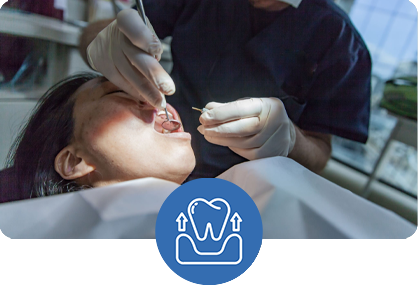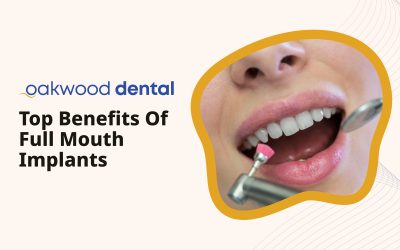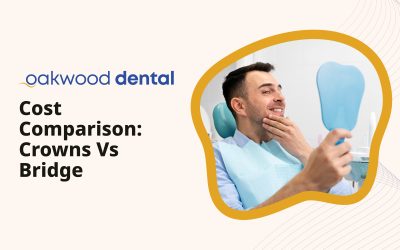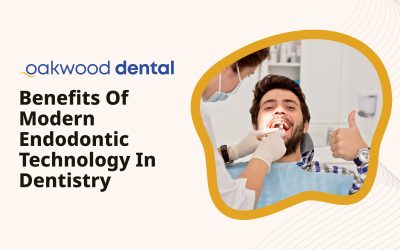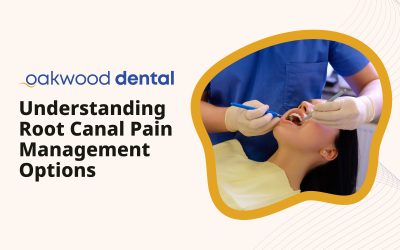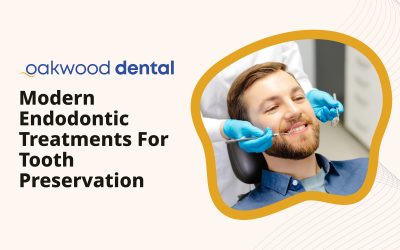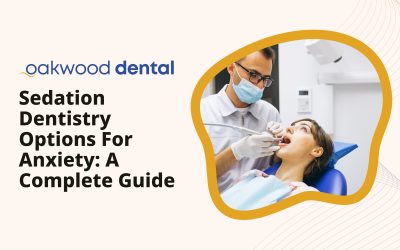Key Takeaways
- Create a dental emergency kit with essential supplies including pain relievers, gauze, and temporary dental cement
- Know how to handle common dental emergencies like knocked-out teeth and severe pain within the critical first 30 minutes
- Save your dentist’s emergency contact information in multiple locations for quick access
- Understand when to seek immediate professional care versus when home treatment is appropriate
- Follow prevention strategies such as wearing mouthguards and maintaining regular dental visits to minimize emergency risks
- Know the proper first aid techniques for different dental emergencies to improve treatment outcomes
Understanding Dental Emergencies
Dental emergencies can happen unexpectedly and require immediate attention to prevent further complications. At Oakwood Dental Clinics, we understand that being prepared for these situations can make a significant difference in preserving your oral health and minimizing discomfort, potentially saving teeth that might otherwise be lost to trauma or infection.
Dental emergencies include a range of situations, from severe toothaches and knocked-out teeth to broken dental restorations and soft tissue injuries. The key to managing these emergencies effectively lies in preparation and knowing the appropriate steps to take when they occur. Recognizing the signs of a true dental emergency versus a non-urgent dental issue can help you make informed decisions about seeking care and taking immediate action.
Emergency dental care is crucial for patients experiencing severe tooth pain, swelling, or dental trauma. These situations require immediate attention to prevent further damage or complications, including potential spread of infection to other parts of the body or permanent tooth loss. Our emergency dental services are designed to provide prompt relief and effective treatment when you need it most, with protocols in place to see emergency patients as quickly as possible.
The three most common dental emergencies include knocked-out permanent teeth, severe toothaches, and post-extraction complications such as bleeding and pain. Understanding how to respond to these situations can help manage the emergency until professional help is available. Each minute counts, particularly with avulsed (knocked-out) teeth, where proper handling within the first 30 minutes significantly increases the chances of successful reimplantation.
Creating Your Dental Emergency Kit
Having a well-stocked dental emergency kit at home can be invaluable when unexpected oral health issues arise. This preparation allows you to provide immediate care while arranging for professional treatment, potentially alleviating pain and preventing further damage to teeth or soft tissues.
Essential Items for Your Kit:
1. Pain management supplies: Over-the-counter pain relievers like ibuprofen or acetaminophen (always follow package directions and consider any medical conditions or allergies)
2. Gauze pads: To control bleeding and apply pressure to injured areas, sterile if possible
3. Small container with lid: For storing a knocked-out tooth, ideally one that can maintain moisture
4. Saline solution: For rinsing wounds or preserving a knocked-out tooth when milk isn’t available
5. Cotton balls: For applying medication or pressure to specific areas
6. Dental wax: To temporarily cover broken braces, wires, or sharp edges of fractured teeth
7. Cold compress or ice pack: To reduce swelling and numb pain (wrapped in cloth to prevent tissue damage)
8. Temporary dental cement: For securing loose crowns or fillings until professional care is available
9. Dental floss: For removing food particles causing pain or pressure between teeth
10. Tweezers: For handling small items or removing foreign objects when appropriate
Keep your emergency kit in an easily accessible location and check it periodically to ensure supplies haven’t expired. Consider keeping duplicate kits in your car, workplace, or vacation home if applicable. Additionally, store your emergency dentist’s contact information with the kit for quick reference, along with any relevant insurance information that might be needed during an emergency visit.
Regular dental checkups and cleanings can help prevent many emergencies by identifying potential problems before they escalate. Issues like small cavities, hairline cracks, or loose restorations can be addressed during routine visits before they develop into painful emergencies requiring urgent care. During these visits, don’t hesitate to ask your dentist about specific items to include in your emergency kit based on your personal oral health needs, especially if you have special conditions like orthodontic appliances or implants.
Handling Common Dental Emergencies
Knowing how to respond to common dental emergencies can help minimize damage and improve outcomes. Here’s guidance on handling the most frequent dental emergency situations, with specific steps to take immediately after the incident occurs.
Knocked-Out Tooth
A knocked-out (avulsed) tooth is one of the most time-sensitive dental emergencies. Quick action can make the difference between saving and losing the tooth permanently, with successful reimplantation most likely when treatment occurs within 30-60 minutes.
If your tooth gets knocked out, first find the tooth and hold it by the crown (the visible part), not the root. Gently rinse it with milk or saline solution if it’s dirty, but don’t use water as it can damage the root cells. Try to put the tooth back in its socket if you can, facing the right way, and bite down gently on gauze to hold it in place. If you can’t put it back in, store the tooth in milk, saline solution, or even in your mouth between your cheek and gums. Get to a dentist as fast as you can – ideally within 30 minutes – because the chance of saving the tooth drops a lot after this time.
Severe Toothache
Toothaches can range from mild discomfort to debilitating pain and often indicate underlying issues that require professional attention, such as deep decay, infection, or abscess formation.
To manage a severe toothache, start by rinsing your mouth with warm saltwater (mix 1/2 teaspoon salt in 8 ounces of water) to reduce swelling and kill bacteria. Gently floss around the painful tooth to remove any trapped food that might be causing pressure. Apply a cold compress to your cheek for 15-20 minutes, then take it off for 20 minutes, and repeat as needed. You can take over-the-counter pain relievers following the package directions. Call your dentist for an appointment and tell them exactly when the pain started and what makes it worse. Remember not to put aspirin directly on your gum or tooth – this can actually burn your tissues.
Knowing what to do when a dental emergency occurs can help you manage pain and prevent further complications until you can see a professional. This knowledge is particularly important for severe toothaches, which can indicate serious underlying conditions requiring prompt treatment.
Broken or Cracked Tooth
Teeth can break or crack due to trauma, biting hard objects, or underlying decay. The severity of the fracture determines the urgency of treatment, with pain, sensitivity, and sharp edges being common symptoms.
If you break or crack a tooth, rinse your mouth with warm water right away to clean the area and remove any loose pieces. If there’s bleeding, press a piece of gauze on the area until the bleeding stops (usually takes 10-15 minutes). Put a cold compress on your face to reduce swelling and help with pain – apply it for 15-20 minutes at a time. If there are sharp edges that could cut your tongue or cheeks, cover them with dental wax. Try to save any broken pieces of tooth and store them in milk or saline solution. Call your dentist as soon as possible, because even small cracks can get worse or lead to infection if not treated.
In cases where a tooth cannot be saved, dental implants provide an excellent long-term solution by replacing the tooth root and preventing bone collapse. These titanium posts integrate with your jawbone, creating a stable foundation for replacement teeth that look, feel, and function like natural teeth. For situations requiring immediate intervention, emergency tooth extraction may be necessary to alleviate pain and prevent infection spread, particularly when a tooth is severely damaged, infected, or causing significant pain that cannot be managed with other treatments.
When to Seek Immediate Professional Help
While some dental issues can be temporarily managed at home, certain situations require urgent professional attention. Recognizing these scenarios can prevent serious complications and potentially save teeth or even lives, as dental infections can spread to other parts of the body if left untreated.
Critical Dental Emergency Signs
Seek immediate professional dental care if you experience:
1. Uncontrolled bleeding from the mouth that doesn’t stop with pressure after 15-20 minutes of applied pressure
2. Severe facial or oral swelling that affects breathing or swallowing, which could indicate a serious infection
3. Signs of infection including fever, facial swelling, and severe pain, especially if accompanied by a foul taste or odor
4. Trauma to the jaw that may indicate a fracture, often accompanied by difficulty opening or closing the mouth
5. Loose teeth in adults (not normal and indicates a serious problem with bone support or trauma)
6. Chemical burns to oral tissues from accidental exposure to caustic substances
7. Foreign objects lodged between teeth that cannot be removed with floss and are causing pain or injury
Selecting the right emergency dentist is crucial for receiving prompt, effective care during dental crises. Look for providers who offer extended hours, same-day appointments, and have experience handling various emergency situations. Establishing a relationship with an emergency dentist before an actual emergency occurs can streamline the process when urgent care is needed.
In some cases, extractions may be necessary when teeth cannot be saved due to extensive damage, infection, or other complications. Our gentle dentists at Oakwood Dental Clinics strive to make this process as comfortable as possible while providing comprehensive care, including discussing replacement options when appropriate to maintain oral function and aesthetics.
Emergency Room vs. Dental Office
Understanding when to visit the emergency room versus a dental office can save time and ensure appropriate care. This distinction is important because many hospital emergency departments aren’t equipped with dental specialists or the specific tools needed for dental procedures.
You should go to the emergency room if you have facial trauma with possible broken bones, severe swelling affecting your breathing or swallowing, uncontrolled bleeding that continues after 20 minutes of pressure, serious head or neck injury along with dental trauma, or signs of serious infection with high fever and facial swelling when you can’t reach a dentist.
You should visit a dental office for knocked-out, loose, or cracked teeth, severe toothache without breathing problems or signs of widespread infection, lost fillings or crowns, broken dentures or braces, or an abscess or gum infection without severe swelling.
Emergency Dental Care Checklist
- ✅ Call your dentist immediately, explaining the situation clearly and concisely
- ✅ Describe your symptoms clearly, including pain level, swelling, and any visible changes
- ✅ Follow first aid steps appropriate for your situation while awaiting your appointment
- ✅ Bring your dental insurance information and identification to expedite registration
- ✅ Have someone drive you if you’re in severe pain or have taken medication that impairs driving
- ✅ Bring any dislodged tooth fragments or dental work carefully preserved in appropriate medium
Prevention Strategies for Dental Emergencies
While not all dental emergencies can be prevented, many can be avoided or minimized through proactive measures. Implementing these strategies can significantly reduce your risk of experiencing dental emergencies and their associated pain, inconvenience, and expense.
Protective Measures During Physical Activities
Sports and recreational activities account for a significant percentage of dental injuries, particularly among children and young adults. Taking proper precautions can prevent these traumatic incidents:
To protect your teeth during physical activities, wear a properly fitted mouthguard during contact sports or activities where you might fall. Custom mouthguards from your dentist offer the best protection and comfort. Use a helmet with face protection when appropriate for activities like cycling, hockey, football, or skateboarding. Remember to take out removable orthodontic retainers during sports unless they’re specially designed for athletics. In daily life, avoid using your teeth to chew ice, popcorn kernels, or hard candies that can crack teeth, especially if you have fillings or crowns. And never use your teeth as tools to open packages or cut things – teeth are meant for chewing food, not as all-purpose tools.
Maintaining Optimal Oral Health
Consistent oral hygiene and regular dental visits are your first line of defense against emergency dental situations, as many emergencies result from untreated dental disease that could have been prevented:
To keep your teeth healthy and avoid emergencies, brush twice daily with fluoride toothpaste, spending at least two minutes each time. Floss at least once a day to clean between teeth where your toothbrush can’t reach. Visit your dentist every six months for checkups, or more often if they recommend it. Don’t ignore small dental problems – get them fixed before they become painful emergencies requiring urgent and more complex treatment. Follow through with treatments your dentist recommends, like fillings or crowns, to fix weakened teeth before they break. And eat a balanced diet without too many sugary foods and drinks that cause tooth decay and can lead to dental emergencies.
Regular dental cleanings and checkups are essential for maintaining oral health and preventing emergencies. These visits allow dentists to identify potential problems early, when they’re easier and less expensive to treat, through professional examinations and diagnostic tools like x-rays that can reveal issues not visible to the naked eye.
At Oakwood Dental Clinics, we offer comprehensive dental services including general dentistry, pediatric dental care, and emergency services to help keep your smile healthy and minimize the risk of dental emergencies. Our preventive approach focuses on education and early intervention to help patients avoid painful and costly emergency situations.
Addressing Existing Dental Issues
Untreated dental problems often escalate into emergencies. Being proactive about addressing these issues can prevent urgent situations and more extensive treatment needs:
Don’t ignore tooth pain or sensitivity – these are warning signs that something might be wrong and needs checking. If you have missing teeth, get them replaced with appropriate restorations to prevent other teeth from shifting, which can cause bite problems and fractures. Repair chipped or cracked teeth quickly before they break further or allow bacteria to enter the tooth pulp. If you grind or clench your teeth, ask about night guards to prevent fractured teeth and worn enamel. Always follow your dentist’s instructions after procedures to ensure proper healing. And maintain your dentures, bridges, or other dental appliances, getting them repaired when needed to prevent complications and emergencies.
For patients with missing teeth, dental implants offer a durable, long-lasting solution that functions like natural teeth. Understanding the facts about dental implants can help you make informed decisions about tooth replacement options, potentially preventing future complications that might arise from gaps in your dentition or less stable replacement methods.
First Aid Techniques for Specific Dental Emergencies
Knowing the appropriate first aid techniques for various dental emergencies can help manage pain, prevent further damage, and improve treatment outcomes while waiting for professional care. These techniques can make a significant difference in the prognosis and ultimate outcome of dental emergencies.
For Soft Tissue Injuries
Injuries to the lips, cheeks, gums, or tongue can be painful and often involve bleeding, which may appear more severe due to mixing with saliva:
For injuries to your mouth’s soft tissues, gently clean the area with warm water to remove any dirt and see how bad the injury is. Apply pressure with clean gauze or cloth for 15-20 minutes to stop bleeding, changing the gauze if it gets soaked. Use cold compresses on the outside of your mouth to reduce swelling and slow down bleeding. For lip injuries, apply pressure and cold compresses, but also check if there’s damage to the teeth behind the lip. If your tongue is injured, carefully pull it forward and press gauze against the wound, being careful not to block your breathing. See a dentist if bleeding continues for more than 15-20 minutes or if the wound is large, deep, or has edges that don’t come together.
For Lost Fillings or Crowns
Losing a filling or crown can expose sensitive tooth structure and cause pain, particularly when the area is exposed to air, temperature changes, or pressure:
If you lose a filling or crown, try to find it if possible, as your dentist might be able to reuse it. Rinse both your tooth and the lost piece gently with warm water to clean them. If you’ve lost a filling, you can put dental cement (available at drugstores) in the cavity as temporary protection. If a crown comes off, you might be able to temporarily reattach it using dental cement or even toothpaste (never use super glue!), making sure it’s facing the right way. Don’t chew on that side of your mouth to avoid damaging the exposed tooth further. See your dentist as soon as possible for a proper repair, since these temporary fixes won’t last long.
Understanding when emergency extractions are necessary can help you prepare for situations where saving a tooth isn’t possible. In these cases, knowing what to expect during and after the procedure can ease anxiety and improve recovery, including information about post-extraction care to prevent complications like dry socket.
For Orthodontic Emergencies
Braces and other orthodontic appliances can sometimes cause discomfort or emergencies, particularly after adjustments or due to broken components:
If you have braces and a wire is sticking out, use the eraser end of a pencil to gently push it flat against your tooth. Don’t bend it sharply as it might break. Cover any sharp edges with orthodontic wax, a small piece of gauze, or even a bit of sugarless gum as a temporary fix. If brackets come loose, use wax to hold them in place temporarily and prevent them from rubbing against your cheeks or lips. If a wire is poking you and you can’t get to your orthodontist, you can clip it with clean nail clippers as a last resort, but be careful not to swallow any pieces. For mouth sores caused by your braces or other appliances, rinse with salt water and apply an over-the-counter oral pain gel.
Dental Emergency Kit Checklist
- 📱 Emergency dentist contact information (office and after-hours numbers)
- 🩹 Sterile gauze pads for controlling bleeding and applying pressure
- 💊 Over-the-counter pain relievers (appropriate for your medical conditions)
- 🧂 Salt (for saltwater rinses to reduce inflammation and kill bacteria)
- 🧊 Small container (for tooth storage, preferably with a secure lid)
- 🧴 Dental cement (temporary, for lost fillings or crowns)
- 🔍 Dental wax (for covering sharp edges or stabilizing loose orthodontic components)
- ❄️ Ice pack or cold compress (reusable or instant activation type)
- 🧤 Small pair of tweezers (sterilized before use)
- 🧵 Dental floss (regular and threaders for braces if applicable)
Post-Emergency Dental Care
After receiving professional treatment for a dental emergency, proper follow-up care is essential for complete recovery and preventing future complications. The days and weeks following emergency dental treatment are critical for healing and long-term success of the procedures performed.
Recovery and Aftercare
Following your dentist’s specific instructions is crucial for healing after a dental emergency. These guidelines are tailored to your specific situation and treatment:
Take all medications exactly as prescribed, especially antibiotics, which you should finish completely even if you start feeling better. Follow any food restrictions carefully – usually soft foods and avoiding very hot or cold items for a few days to protect healing areas. Keep the area clean as your dentist directs, which might mean brushing differently or using special mouth rinses. Apply cold packs as recommended for swelling, typically 15-20 minutes on and 20 minutes off during the first day or two. Go to all your follow-up appointments, even if you feel fine – these visits let your dentist check your healing and make any needed adjustments. Tell your dentist right away if you notice worse pain, more swelling, bleeding, or any signs of infection.
Long-term Considerations
After experiencing a dental emergency, consider these long-term strategies to prevent recurrence and maintain optimal oral health:
Talk with your dentist about ways to prevent similar problems in the future, such as getting a custom mouthguard for sports or a night guard if you grind your teeth. Discuss options for fixing damaged or missing teeth, understanding the pros and cons of each approach. Look at your daily tooth care routine and see if you need to make changes, maybe adding tools like a water flosser. Think about what might have caused your emergency – like teeth grinding or risky activities – and how to address these factors. Update your emergency dental kit based on what you learned from this experience, adding items that would have been helpful. And consider extra protection like custom mouthguards for activities that might have caused your emergency.
When extractions are necessary, understanding proper aftercare is essential for preventing complications like dry socket or infection. Following post-extraction instructions carefully will promote healing and reduce discomfort, including avoiding smoking, not using straws, and maintaining gentle cleaning around the extraction site.
Emotional Aspects of Dental Emergencies
Dental emergencies can be traumatic and may cause anxiety about future dental visits. Addressing the psychological impact is an important part of complete recovery:
Tell your dental team about any fears or concerns you have – they can provide reassurance and make your visits more comfortable. Try relaxation techniques like deep breathing, imagining peaceful scenes, or listening to music during dental visits. Focus on the positive outcomes of your treatment and how you can prevent future problems. If dental anxiety continues to be a problem, consider getting help through counseling or finding a dental practice that specializes in treating anxious patients. Remember that most dental emergencies are successfully treated when addressed quickly, and modern dentistry offers many ways to make treatment more comfortable.
At Oakwood Dental Clinics, our experienced team is committed to providing compassionate care during dental emergencies. Our patients consistently report positive experiences, even during stressful emergency situations, thanks to our emphasis on both technical expertise and emotional support throughout the treatment process.
Special Considerations for Different Age Groups
Dental emergencies affect different age groups in unique ways, requiring tailored approaches for prevention and management based on developmental stages, activities, and existing oral health conditions.
Children and Adolescents
Young patients have special considerations during dental emergencies due to developing dentition, growth patterns, and activity levels:
For baby teeth, different rules apply – ask a dentist before trying to put a knocked-out baby tooth back in, as this could harm the permanent tooth growing underneath. Sports injuries are common in kids, so custom mouthguards are strongly recommended, especially during growth spurts when teeth may be more vulnerable. Orthodontic emergencies need specific approaches depending on the type of braces or appliance. Emotional support is extra important for kids to prevent them from developing dental fears that could make them avoid dental care later in life. Using simple, age-appropriate explanations about what’s happening helps reduce fear and builds trust with the dental team.
Adults with Existing Dental Work
Adults with restorations, implants, or other dental work have specific emergency considerations based on their existing treatments and oral conditions:
Loose or fallen-out crowns and bridges need quick attention to protect the teeth underneath. Implant emergencies may show different symptoms than problems with natural teeth and need special treatment approaches. If dentures break, emergency repair kits can help temporarily until professional repair is possible. Even teeth that have had root canals can still have emergencies, including cracks or new infections that need specialized treatment. Teeth grinding and clenching can damage existing dental work, so night guards may be needed along with possible adjustments to crowns or fillings.
Understanding common dental emergencies can help you recognize warning signs and take appropriate action when problems arise, potentially saving teeth and preventing more extensive treatment needs through early intervention.
Seniors and Patients with Medical Conditions
Older adults and those with medical conditions face unique challenges with dental emergencies due to medication interactions, chronic conditions, and age-related changes:
Medication interactions must be considered during emergency treatment, especially blood thinners that can affect bleeding. Chronic conditions like diabetes can slow healing and increase infection risk, requiring special approaches to care. Mobility issues might make it harder to get to emergency appointments, so home care instructions and transportation planning are important. Denture-related emergencies happen more often, including fit problems that can hurt tissues or make eating difficult. Clearly sharing your complete medical history during emergency visits is crucial, including all medications and any recent changes in your health.
Quick Reference Guide: When to Call Your Dentist Immediately
- ⚠️ Knocked-out tooth (minutes matter for saving the tooth, with success rates highest within 30 minutes)
- ⚠️ Severe pain not manageable with over-the-counter medication, especially if worsening or throbbing
- ⚠️ Significant swelling of the face, gums, or jaw, particularly if spreading rapidly or affecting breathing
- ⚠️ Bleeding that doesn’t stop after 15 minutes of pressure, indicating possible vascular damage
- ⚠️ Broken tooth with severe pain or sharp edges that could damage soft tissues
- ⚠️ Signs of infection (fever, swelling, pus, foul taste/odor) which could spread to other areas
- ⚠️ Trauma to the jaw that may indicate fracture, especially with difficulty opening or closing mouth
Choosing the Right Emergency Dental Care Provider
Having an established relationship with an emergency dental provider before an emergency occurs can save precious time and reduce stress during urgent situations. This proactive approach ensures you know exactly who to call and where to go when minutes matter.
What to Look for in an Emergency Dentist
Consider these factors when selecting an emergency dental provider to ensure you receive appropriate care when needed:
Look for a dentist with extended or flexible hours, including evenings and weekends, so you don’t have to wait long for care. Find one who offers same-day emergency appointments and has clear instructions for after-hours care. Choose someone experienced in handling various dental emergencies like trauma, infections, and broken dental work. Pick a practice that offers many services so you don’t need multiple referrals for different problems. Make sure they communicate clearly about their emergency procedures, including how to contact them after hours. Consider the location – closer to home or work means less travel time during an emergency. And check what insurance they accept and what payment options they offer for unexpected emergency expenses.
Our guide on choosing an emergency dentist provides detailed information to help you select the right provider for your needs. This proactive step can make a significant difference when emergencies occur, ensuring you receive appropriate care without unnecessary delays or complications.
Questions to Ask Potential Emergency Dentists
Before establishing a relationship with an emergency dental provider, consider asking these important questions to understand their emergency care protocols:
“What is your protocol for after-hours emergencies?” This helps you know exactly how to get help when the office is closed. “How quickly can emergency patients typically be seen?” This gives you a realistic timeframe for different types of emergencies. “What types of dental emergencies do you handle in-office versus refer out?” This ensures they can manage your likely needs. “What emergency services are covered under my insurance plan?” This helps you understand potential costs before an emergency happens. “Do you offer sedation options for emergency procedures?” This is important if you’re anxious or might need complex procedures. “What payment options are available for emergency care?” This helps you plan for the financial aspects of emergency treatment.
At Oakwood Dental Clinics, we pride ourselves on providing prompt, effective emergency dental care. Our team is trained to handle various dental emergencies with compassion and expertise, with protocols in place to see emergency patients as quickly as possible and provide appropriate treatment options for different situations.
Conclusion
Being prepared for dental emergencies is an essential aspect of maintaining optimal oral health. By understanding common emergency situations, creating a well-stocked dental emergency kit, and knowing the appropriate first aid techniques, you can effectively manage dental crises until professional help is available, potentially saving teeth and preventing permanent damage.
Remember that prevention plays a crucial role in avoiding many dental emergencies. Regular dental checkups, proper oral hygiene practices, and protective measures during physical activities can significantly reduce your risk of experiencing dental trauma. Taking a proactive approach to oral health maintenance is your best defense against painful and costly emergency situations.
When emergencies do occur, having an established relationship with a trusted emergency dental provider ensures you can receive prompt, effective care. At Oakwood Dental Clinics, we’re committed to providing comprehensive emergency dental services to address your urgent oral health needs, with experienced professionals who understand the importance of quick intervention and compassionate care.
By following the guidelines outlined in this article, you’ll be well-equipped to handle dental emergencies with confidence, potentially saving teeth, reducing discomfort, and improving treatment outcomes. Your preparation today can make a significant difference in managing tomorrow’s unexpected dental situations, ensuring that you and your family are ready to respond appropriately when dental emergencies arise.
Key Actions to Remember
- Prepare a dental emergency kit and keep it accessible in multiple locations where you spend time
- Save your dentist’s emergency contact information in your phone and share it with family members
- Know the appropriate first aid techniques for different dental emergencies to minimize damage
- Understand when to seek immediate professional help versus when home management is appropriate
- Follow preventive measures to reduce your risk of dental emergencies through lifestyle and care choices
- Establish a relationship with an emergency dental provider before emergencies occur to streamline care

 718-979-2121
718-979-2121

